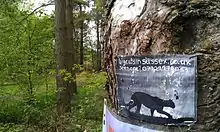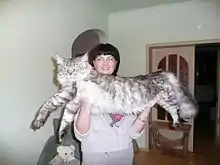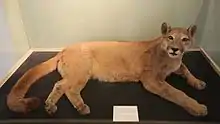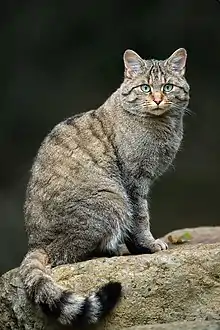British big cats
In British folklore, British big cats, also referred to as ABCs (Alien, or Anomalous, Big Cats), phantom cats and mystery cats, are reports and incidents of Felidae are native to Britain but supposed to inhabit the British countryside. These sightings are often reported as "panthers", "pumas", or "black cats".

A fringe theory suggests that the animals may be surviving Ice Age fauna[1] where leopards, scimitar-toothed cats, lions, and lynxs had been found in British Isles. However, the existence of a population of true big cats in Britain, especially a breeding population, is believed to be highly implausible by experts owing to lack of convincing evidence. There have been some incidents of recovered individual animals, often medium-sized species such as the Eurasian lynx, but in one 1980 case a puma was captured alive in Scotland.[2] These are generally believed to have been escaped or released pets that had been held illegally, possibly released after the animals became too difficult to manage.[1] Sightings at a distance may possibly be explicable as domestic cats seen near to a viewer being misinterpreted as larger animals seen farther away.[3][4][5] In his 2013 book Feral, George Monbiot argues that humans are programmed to notice things that might be big cats because of the threat they posed in prehistoric times. Some believe that the introduction of Dangerous Wild Animals Act 1976 might have resulted in releases of captive animals into the wild.[6]
Reported sightings
Documentation
The research group Big Cats in Britain publishes reported sightings annually by county. The "top ten" counties or regions of Great Britain between April 2004 and July 2005 were:[7]
| Area | Devon | Yorks | Scotland | Wales | Gloucs | Sussex | Cornwall | Kent | Somerset | Leics |
|---|---|---|---|---|---|---|---|---|---|---|
| Number of Sightings | 132 | 127 | 125 | 123 | 104 | 103 | 99 | 92 | 91 | 89 |
First sightings
The great radical writer, William Cobbett recalled in his Rural Rides how, as a boy in the 1760s, he had seen a cat "as big as a middle-sized Spaniel dog" climb into a hollow elm tree in the grounds of the ruined Waverley Abbey near Farnham in Surrey. Later, in New Brunswick, he saw a "lucifee" (North American lynx – Felis lynx canadensis) "and it seemed to me to be just such a cat as I had seen at Waverley."[8] Another report appeared in the Daily Express on 14 January 1927 of a "lynx" being seen.
Further back there is a medieval Welsh poem Pa Gwr in the Black Book of Carmarthen which mentions a Cath Palug, meaning "Palug's cat" or "clawing cat", which roamed Anglesey until slain by Cei. In the Welsh Triads, it was the offspring of the monstrous sow Henwen.[9]
Recent sightings
Current interest in big cat reports appears to stem from the late 1950s, with news stories of the Surrey Puma and the Fen Tiger. In 1963 the Shooters Hill "cheetah" was reported from that area of London.[10] and in 1964 came similar reports from Norfolk.[11] From the 1970s reports spread across the country; the Beast of Exmoor was reported from Devon and Somerset and the Sheppey Panther has been rumoured to exist since that decade.[12] In 1980 came the first modern report from Scotland, and the Kellas Cat was shot there in 1984.
Greater interest in phantom cats grew from headline stories of the Beast of Bodmin from 1992, and Dumfries and Galloway (the Galloway Puma). In the historic Buchan area of Aberdeenshire the creature is dubbed the Beast of Buchan and sightings are regularly documented.[13] A black panther known as the "Beast of Dartmoor" was reportedly seen by a group of fifteen people, including Matthew P. Warburton, in the summer of 2011 in the Haldon Forest.[14][15] There were many more news stories from different parts of the country.[16][17][18][19][20][21][22][23]
In the early months of 2011, a great number of sightings of a 'panther' in Shotts, North Lanarkshire, stirred locals and began to be reported in the local press, after a couple of months, these reports ceased with the assumption that the 'panther' had moved onto pastures new.[24]
One of the most recent reports was of that of the "Essex Lion", a lion purportedly roaming around Essex during the summer of 2012. Initially sighted from a caravan park, there were also reports of lion roaring heard in the local area. A photograph was taken by one witness. Police advised local residents to stay indoors and a search was made of the local area, but nothing was found. Local zoos and visiting circuses were contacted, but none reported an escaped lion. A Ms Murphy later claimed the photograph was that of her pet Maine Coon cat, Teddy.[25]
In 2013, in a small village on the Shropshire-Wrexham border, two sisters reported seeing a large, black, cat-like creature with a three-foot (1 m) stride jumping a fence and disappearing into a neighbouring field. On returning in the day, they discovered a large lair and paw prints too big to belong to a domesticated cat. A one time zoo-keeper at Chester Zoo and Dudley Zoo, Mr Larkham, agreed that the paw prints do not belong to a domesticated cat but were too small to be those of a panther. He believed it could be the descendant of the Shropshire jungle cat from the 1980s, or a gigantic domesticated cat.[26]
In April 2019 it was claimed that a big cat was sighted in the Cornish village of Harrowbarrow, after it attacked a dog. Residents claimed that five local pet cats had disappeared and that a local herd of deer was no longer visiting the fields near the village. A large paw print, identified as that of a panther or puma by the RSPCA was also found. Footage of a black panther-like cat emerged a few days later.
Species that have been noted only occasionally include the leopard cat, which is the size of a domestic cat but has leopard-like spots, the clouded leopard, a specialised species from the tropics which was captured after living wild in Kent in 1975, and there are even extraordinary cases of lions being reported in Devon and Somerset.[16]


In August 2012, several sightings of a lion were reported near St. Osyth in Essex. Police searched the area using helicopters and infrared cameras, instructing residents to stay in their homes. Despite speculation that the lion had escaped from Colchester Zoo or a local circus, all such animals were accounted for. The search was called off the next day with no evidence of a lion having been found.[29] A local resident claimed that a photo of the alleged animal showed their pet cat, a large Maine Coon.[25][30]
There have been reports of a cat known as the Beast of Bevendean for several years across Sussex, including in Brighton and Hove.[31] A fictional attempt to trap the Beast is the subject of the film Young Hunters: The Beast of Bevendean (2015).[32]
Evidence
Captures and remains

A Canadian lynx shot in Devon in 1903 is now in the collection of the Bristol Museum.[33] Analysis of its teeth suggests that prior to its death it had spent a significant amount of time in captivity.[33]
In 1980 a puma was captured in Inverness-shire, Scotland. The capture followed several years of sightings in the area of a big cat matching the description of the one captured, which had led local farmer Ted Noble to erect a cage trap. The puma was subsequently put into the Highland Wildlife Park zoo and given the name "Felicity". When it died it was stuffed and was placed in Inverness Museum.[34] Zoo director Eddie Orbell concluded that the animal had been tamed and might not have been released for long, noting that it enjoyed being tickled.[35]
In 1989 a jungle cat that had been hit by a car was found on the roadside in Shropshire.[36]
In 1991 a Eurasian lynx was shot near Norwich, Norfolk. It had killed around 15 sheep within two weeks. The story was only reported in 2003, and the stuffed body of the lynx is allegedly now in the possession of a collector. For many years this incident was considered to have been a hoax, particularly by the hunting community, but in March 2006 a police report confirmed that the case was true. It was probably an escapee from a facility in the area that bred animals, including Eurasian lynxes.[37]
In 1994 it was reported that a large cat with leopard-pattern fur had been shot on the Isle of Wight some time earlier after feasting on chickens and ducks. The shooting was not immediately reported as the farm worker involved feared prosecution, but police reportedly concluded that the animal was an ocelot or serval.
There have been reports that in 1993 yet another puma was captured in Scotland, this time in the Aviemore area.[34][38]
In 1996, police in Fintona, County Tyrone, Northern Ireland shot a cat. It was reportedly a caracal, a medium-sized wildcat species found in Africa and Asia, although a police report described it as a lynx.[3][39] (Caracals are sometimes called desert lynxes, but are not true members of the genus Lynx.)[40]
In a well-reported 2001 case ("the Beast of Barnet"), a young female Eurasian lynx was captured alive by police and vets in Cricklewood, north-London, after a chase across school playing fields and into a block of flats. It was placed in London Zoo and given the name "Lara" before ultimately being transferred to a zoo in France to breed.[41][42] The captured lynx was found to be only 18 months old, although considerably larger than an average domestic cat.[3][43]
In November 2017, a trucker claimed to have seen three highways workers struggling to lift the body of a dead 4 foot black panther into the back of a truck in a lay-by on the A1 near Harworth.[44] However, Highways England responded with a statement to say that it was a dead black dog that they had loaded onto the back of the truck.[44]
Video and photographic evidence

Around 1993, a number of reports were made of a large black cat around Bodmin Moor, nicknamed the "Beast of Bodmin", with at least two videos made. Some video evidence was examined by government scientists, who concluded from the position of the camera and animal that the sightings were of black cats no more than 30 cm (12 in) high at the shoulder.[4][5]
In 1994 footage of a large black cat was recorded in Cambridgeshire and was named in the media as the "Fen Tiger".[46]
In June 2006 a large black cat was recorded in the countryside of Banff, Aberdeenshire. Footage of the cat was broadcast by the BBC on 24 May 2007.[47]
In July 2009, photographs and video footage of a large black cat were taken by an off-duty Ministry of Defence Police officer. The animal was walking along a railway line in Helensburgh, Argyll. Large cats, either black or tan, have been reported in the area before.[48]
In late 2009 video footage of what is claimed to be a large black cat was recorded in Herefordshire.[49] The sighting and video footage of the alleged big cat coincided with a spree of sheep killings in the same area.[50]
In 2010 video footage of what is claimed to be a large black cat was recorded in Stroud, Gloucestershire.[51] 'Experts' have estimated that the creature was at least five feet (1.5 m) in length from nose to tail.[52]
In 2011 a family walking in Fochabers Wood, Moray, photographed a large black cat matching the description of a forest jaguar.[53]
In 2013, photos were taken of what appeared to be a large black cat on the estate of Sir Benjamin Slade, 7th Baronet in Somerset.[54]
In 2017 there were five sightings of big cats in Gloucestershire, some with photographic evidence.[55]
In April, 2017, a mother and her teenage daughter took several photos of what appears to have been a large black big cat in the Quantock Hills, Somerset, which was speculated by BeastWatch UK, a non-profit organisation that collates and reports on exotic wildlife, that it could have been a panther or jaguar.[56]
A 2017 documentary included footage taken by an off-duty police officer in the West Midlands of a large black cat that was analysed by a big cat expert from South Africa who concluded that it had the characteristics of a black leopard.[57] He also analysed footage taken of a large black cat in the village of Maiden Newton, Dorset and said that it was the "most conclusive evidence so far that a black leopard is on the loose in the UK".[58]
In 2020, a serval-like cat was photographed in North London. [59]
Attacks
In 2000 an 11-year-old boy in Monmouthshire was attacked by what he claims was a large black cat. It left him with five long claw marks across his left cheek. The police called in a big cat expert to investigate the incident.[60]
In 2005 a man who lived in Sydenham Park in south-east London was attacked in his back garden, which backed onto a railway line. The man who was 6 ft (1.8 m) and weighed 15 stone (210 lb; 95 kg) described the cat as being a big black figure that pounced on him and was considerably stronger than he was. He was left with scratches all over his body. Police were called and according to the BBC, one police officer saw a cat the size of a Labrador dog.[61] The man who was attacked sustained scratches to his face and the alleged big cat was named locally as the "Beast of Sydenham".[62]
In 2008, it was reported that a 74-year old women was attacked on two separate occasions by a large cat in Alness, Scottish Highlands, leaving her with injuries, but a Scottish wildcat expert concluded that it was most likely a large feral domestic cat living wild, possibly a hybrid with a Scottish wildcat, but ruled out that a Scottish wildcat itself was responsible for the attacks.[63]
In 2019 a man in Cornwall reported that a 6 ft (1.8 m) black cat attacked him through an open window and that it was trying to get in through the window.[64][65] He described it as being crossed between a domestic cat and a panther.[64][65] He was said to have have reported it to the police and claimed "that they were not interested".[65]
DNA evidence
There have been conflicting reports of DNA evidence as to the existence of big cats in Britain: In 2011 it was announced by the Centre for Fortean Zoology that DNA testing, carried out by Durham University on hairs found in north-Devon, showed that a leopard was living in the area.[66] In 2012 it was announced that DNA testing on two deer carcasses found in Gloucestershire found only fox DNA, despite many locals reporting sightings and believing that the deer had been killed by a big cat.[67]
The Cotswolds big cat
The "Cotswolds big cat" is a purported big cat or number of big cats at large in the Cotswolds region of England.[68][69][70]
A walker in Woodchester Park found the carcass of a roe deer on 12 January 2012, with injuries suggesting the animal may have been mauled by a large felid.[68] A second similar deer carcass was found on 16 January 2012.[69]
An analysis of the deer carcasses by University of Warwick scientists only indicated DNA evidence of foxes and other deer.[71]
Government involvement
In 1988, the Ministry of Agriculture took the unusual step of sending in Royal Marines to carry out a massive search for the rumoured Beast of Exmoor after an increase in the number of mysteriously killed livestock, and farmer complaints over subsequent loss of money. Several Marines claimed to have seen the cat fleetingly, but nothing other than a fox was ever found. The Department for Environment, Food and Rural Affairs has published a list of predatory cats that they know to have escaped in the United Kingdom, although most of these have been recaptured.[72]
Mythological explanation
For many hundreds of years the myth of the spectral Black Dog has persisted in Britain – a supposed mythical creature appearing as a large black animal in remote moorland with no firm evidence for its existence, beyond hearsay. It has been suggested that the stories of "Black Cats" are merely a modern continuation of such myths and stories, sharing the same elements but with the idea of a supernatural cause having fallen out of credibility and the modern, more plausible, idea of an escaped or released wildcat supplanting it.[73] In addition, the stories of big cats share many traits suitable for the tabloid press – as such leading to wide exposure of any potential "cat" and further and rapid dissemination of any speculation or supposed evidence for it, helping to build a widespread urban legend.
See also
- Cryptozoology
- European wildcat
- Kellas cat
- The Siege of White Deer Park – children's novel by Colin Dann featuring a big cat hiding in an English wood
References
- "Naturalist Simon King (interview)". Saturday Live. 8 August 2009. BBC Radio 4.
- Strachan, Graeme. "Big cats: The hunt for the puma caught roaming the Highlands in 1980". Press and Journal. Retrieved 30 October 2020.
- Hambling, David (19 July 2001). "It's a lion... no it's a cat". The Guardian. Retrieved 3 September 2015.
- "Big cats in the UK: Fact or fiction?". BBC. Retrieved 3 September 2015.
- Roberts, Gareth (15 December 2014). "Beast of Bodmin Moor: Mystery solved over 'beast' that slaughtered farm animals for decades". Daily Mirror. Retrieved 3 September 2015.
- https://www.bbc.com/news/uk-england-19397320
- BBC Wildlife Magazine, April 2006.
- Cobbett, William (2001). Rural Rides. London: Penguin. p. 204. ISBN 978-0-14043-579-5.
- "Arthur and the Porter". Celtic Literature Collective. Retrieved 28 July 2009.
- Bord, Janet; Bord, Colin (1980). Alien Animals. London: Paul Elek. pp. 46–48. ISBN 978-0-23640-154-3.
- Bord & Bord (1980) p.50.
- "Is There a Panther Visiting Sheppey?". East Kent Gazette. 11 November 2009. Retrieved 15 April 2010.
- Watson, Jeremy (24 December 2006). "The Beast of Buchan". Scotland on Sunday. p. 16.
- "An encounter with the wild". embercombe.org. Retrieved 3 January 2021.
- "'is there a big cat in my back yard?' (parts 1&2) and 'there IS a Big Cat in my back yard!' (part 3)". wildernessguide.wordpress.com. Retrieved 3 January 2021.
- "Dartmoor Lion". Scottish Big Cat Trust. Retrieved 28 July 2009.
- Tozer, Joe. "It's Basingstoke NOT Boringstoke". Basingstoke.me.uk. Retrieved 28 July 2009.
- Elliott, Emily-Ann (10 June 2008). "Beast of Bevendean strikes again". The Argus. Retrieved 28 July 2009.
- "Big cats sightings are 'reliable'". BBC News. 7 January 2009. Retrieved 27 April 2010.
- "Big cats seen in Forest of Dean". Bristol Evening Post. 6 January 2009. Archived from the original on 8 April 2010. Retrieved 28 July 2009.
- "It was like no other animal I've ever seen before". Harborough Mail. 4 February 2009. Archived from the original on 13 February 2009. Retrieved 28 July 2009.
- "Policeman takes 'big cat' video". BBC News. 28 July 2009. Retrieved 28 July 2009.
- "Beast of Bevendean stalks again". The Argus. 15 October 2010. Retrieved 15 February 2013.
- McLelland, Euan (13 April 2011). "Panther Watch: Seventh sighting as big cat spotted in Shotts". Wishaw Press. Archived from the original on 4 May 2011.
- "'Essex lion was my pet cat Teddy Bear' – owner". BBC News Essex. 28 August 2012. Retrieved 7 August 2013.
- "Sisters are shocked by huge cat like creature". Shropshire Star. 6 March 2013. Archived from the original on 3 March 2016. Retrieved 13 May 2013.
- "World's longest cat dies in Nevada". CBS News. 5 February 2013. Retrieved 6 February 2013.
- Nowak, Ronald M. (1999). Walker's Mammals of the World. 2. JHU Press. p. 831. ISBN 0-8018-5789-9.
- "Essex 'lion': Police call off St Osyth animal search". BBC News. 27 August 2012. Retrieved 27 August 2012.
- Tucker, Abigail (2016). The Lion in the Living Room: How House Cats Tamed Us and Took Over the World. Simon & Schuster. ISBN 978-1476738239. Retrieved 13 November 2016.
- Roberts, Anna (22 September 2011). "The Beast of Bevendean – The Movie". The Argus. Retrieved 15 February 2013.
- "Big cat movie plan by Brighton film school tutor". The Argus. 2 February 2012. Retrieved 15 February 2013.
- Morelle, Rebecca (25 April 2013). "'Big cat' Canadian lynx was on the loose in UK in 1903". BBC News. Retrieved 30 April 2013.
- Smith, Chris. "Felicity the Puma". Scottish Big Cat Trust. Retrieved 2 June 2012.
- McAllister, Bill. "Was it really a leopard that was spotted?". The Inverness Courier. Archived from the original on 24 September 2015. Retrieved 3 September 2015.
- "Big cats in Shropshire: A tall tale or serious threat?". shropshirestar.com. 12 January 2015. Retrieved 7 December 2020.
Contains photographic evidence
- "Police report solves lynx mystery". BBC News. 21 March 2006.
- Smith, Chris. "Second Scottish Puma". Scottish Big Cat Trust. Retrieved 2 June 2012.
- "'Big cat' sightings (FOI request)" (PDF). Police Service of Northern Ireland. Archived from the original (PDF) on 3 April 2014. Retrieved 3 September 2015.
- "Caracal Facts". Big Cat Rescue. Retrieved 4 March 2015.
- Hewett, Chris (11 March 2014). "What became of the 'Beast of Barnet'? Times Series investigation reveals Cricklewood lynx Lara's legacy lives on". This is Local London. Retrieved 19 January 2015.
- O'Neill, Sean (9 May 2001). "The Beast of Cricklewood is caged". The Daily Telegraph. Retrieved 1 September 2010.
- "London Zoo rescues roaming European lynx". Scottish Big Cat Trust. Retrieved 4 June 2012.
- Langley, Robert (21 November 2017). "Road bosses respond to claims '4ft black panther' found on A1". lincolnshirelive.co.uk. Retrieved 17 November 2019.
- "Terror as four lions flee big top". Grimsby Evening Telegraph. 8 March 1991. Archived from the original on 21 April 2015. Retrieved 3 September 2015.
- Osborne, Chris (3 April 2008). "On the Tail of the Tiger". BBC Cambridgeshire. Retrieved 31 May 2012.
- Morse, Felicity (27 August 2012). "Big Cat Sightings: From the Beast of Bodmin to Coulport Cougar, Five Other Cat Tales". Huffington Post (UK). Archived from the original on 25 April 2016. Retrieved 16 February 2014.
- "Policeman takes 'big cat' photo". BBC News. 28 July 2009. Retrieved 28 July 2009.
- "Was Herefordshire's 'big cat'" caught on camera?". Hereford Times. 16 December 2009. Retrieved 1 June 2012.
- Bowen, Mark (29 December 2009). "Sheep killings add to Herefordshire's Big Cat mystery". Hereford Times. Archived from the original on 22 March 2010. Retrieved 1 June 2012.
- "'Black leopard' caught on film in Stroud". The Daily Telegraph. 7 February 2012. Archived from the original on 20 May 2014. Retrieved 14 April 2014.
- "Video captures footage of 'big cat' in Gloucestershire". This is Gloucestershire. 7 February 2012. Archived from the original on 17 April 2012. Retrieved 1 June 2012.
- Crawford, Graham (7 December 2011). "Family encounters big cat in the woods". Banffshire Journal. Archived from the original on 7 April 2014. Retrieved 6 April 2014.
- Marsden, Sam (25 July 2013). "Aristocrat warns visitors after 'big cat' photographed on his estate". The Telegraph. Retrieved 26 August 2019.
- Falconer, Ben (18 May 2018). "Five times big cats have been seen in Gloucestershire in the past year". GloucestershireLive. gloucestershirelive.co.uk. Retrieved 28 August 2018.
- "BEAST OF SOMERSET? Mum and daughter stunned as 'huge cat' prowls in Quantock Hills". Daily Express. 16 April 2017. Retrieved 1 January 2020.
- Tracking The Big Black Cats Of The UK! Real Wild. England: YouTube. 31 May 2017. Event occurs at 22:14 minutes in. Retrieved 26 August 2019.
- Tracking The Big Black Cats Of The UK! Real Wild. England: YouTube. 31 May 2017. Event occurs at 43:05 minutes in. Retrieved 26 August 2019.
- https://www.yorkshirepost.co.uk/lifestyle/heres-what-you-need-know-about-savannah-cats-after-one-was-spotted-uk-garden-2866556
- "Police 'big cat' warning". BBC News. 25 August 2000. Retrieved 2 June 2012.
- "'Big Cat' attacks man in garden". BBC News. 22 March 2005. Retrieved 2 June 2012.
- Davenport, Justin (22 March 2005). "Hunt for 'beast of Sydenham'". Evening Standard. Retrieved 27 October 2020.
- "Expert tears into cat conspiracy". BBC News Online. 29 December 2008. Retrieved 28 March 2020.
- Shaw, Neil (18 January 2019). "Man says he was attacked through window by 6ft big cat in Cornwall". cornwalllive.com. Retrieved 15 September 2019.
- "Man swiped at by 'panther-like' big cat in Cornwall". itv.com. 18 January 2019. Retrieved 15 September 2019.
- "Experts have DNA proof that big cats are still living in the Westcountry". This is Devon. Archived from the original on 7 March 2012. Retrieved 2 June 2012.
- "'Big Cat' in Gloucestershire ruled out by DNA Test". BBC News. 2 February 2012. Retrieved 4 June 2012.
- Morris, Steven (12 January 2012). "Big cat may prowl Gloucestershire wood, says National Trust". The Guardian. Guardian Media Group. Retrieved 4 December 2014.
- Morris, Steven (16 January 2012). "Cotswolds big cat speculation mounts as second dead deer found". The Guardian. Guardian Media Group. Retrieved 3 December 2014.
- Craig, Ian (26 February 2012). "Big cat spotted in Chelworth". Worcester News. Newsquest Media Group. Retrieved 3 December 2014.
- "Cotswolds 'big cat': No DNA evidence". BBC News. British Broadcasting Corporation. 2 February 2012. Retrieved 4 December 2014.
- "Reports received by Defra of escapes of non-native cats in the U.K. 1975 to present day" (PDF). Department for Environment, Food, & Rural Affairs. Archived from the original (PDF) on 10 December 2006.
- "The Beast of Bodmin Moor". The Natural History Museum, London. Retrieved 15 February 2013.